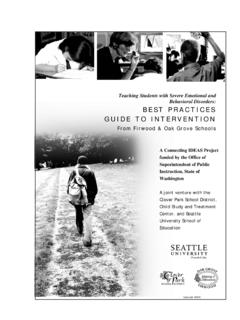Transcription of Seven ways to improve quality and safety in hospitals - …
1 Seven ways to improve quality and safety in hospitals An evidence based guide 2. How to cite this document: - G roene O, Kringos D, Sunol R on behalf of the DUQuE Project. Seven ways to improve quality and safety in hospitals . An evidence-based guide . DUQuE Collaboration, 2014, 3. Executive summar y Purpose of this document Key quality and safety issues | Sources of evidence | Key concepts | References Seven ways to improve quality and safety in your hospital 1. Align organisational processes with external pressure 2. Put quality high on the agenda 3. Implement supportive organisation-wide systems for quality improvement 4. Assure responsibilities and team expertise at departmental level C ontents 5. Organise care pathways based on evidence of quality and safety interventions 6. Implement pathway-oriented information systems 7. Conduct regular assessment and provide feedback Goto >>: Annex 4. Executive summary This guidebook aims to provide an up-dated framework to assess quality and safety improvement in hospitals .
2 It is based on state-of-the art research and synthesises the results of the DUQuE Project and other large-scale empirical studies, systematic reviews, and expert knowledge. The key findings of this synthesis are reflected in Seven ways to improve quality and safety in your hospital . They consist of the following: 1. Align organisational processes with external pressure 2. Put quality high on the agenda 3. Implement supportive organisation-wide systems for quality improvement 4. Assure responsibilities and team expertise at departmental level 5. Organize care pathways based on evidence of quality and patient safety interventions 6. Implement pathway-oriented information systems 7. Conduct regular assessment and provide feedback Hospital managers, quality managers, and professionals can use this tool to reflect on their organisation's strategy for quality improvement, to identify specific actions aimed at improving their strategy and applying it throughout the organisational units.
3 Purchasing agencies can use this tool to ask care providers critical questions about their ways to improve quality and safety . 5. Seven ways to improve quality and safety in your hospital used by quality managers and their teams to guide local Multiple strategies and tools to improve quality and safety question asking and reflection. Multiple assessment tools work have been demonstrated to be effective in improving are referred to that can be used to support reflection quality and safety at the micro system level. The purpose of processes with quantitative measurement. this document is supporting management aligning the use of such strategies and tools. Emphasis is placed on cross- cutting issues such as oversight and leadership, building support systems for quality improvement and providing the necessary resources for high quality care to be provided. The Seven ways to improve quality and safety cover the following: 1. Align organisational processes with external pressure 2.
4 Put quality high on the agenda 3. Implement supportive organisation-wide systems for quality improvement 4. Assure responsibilities and team expertise at departmental level 5. Organise care pathways based on evidence of quality and safety interventions 6. Implement pathway-oriented information systems 7. Conduct regular assessment and provide feedback For each of the Seven strategies, we provide an overview on the underlying evidence base, highlight key issues for further development and suggest prompts that can be 6. Purpose of this document Research on quality improvement methods has resulted in a wide range of assessment tools, statistical techniques and improvement applications in the last decade. There is The number of quality substantial evidence for a large number of clinical and non-clinical interventions to im- improvement tools is prove the quality of care. This is in mismatch to the persistent variations in quality and overwhelming.
5 safety that are consistently documented in the literature and in the media. The question is: where For those in charge of planning and implementing quality management, the wealth of to start? information on quality and safety interventions creates a problem. And: how do I translate hundreds of approaches This document aims to provide an up-dated framework to assess quality and safety im- into a coherent strategy? provement in hospitals . It is based on state-of-the art research and synthesises the results of the DUQuE Project and other large-scale empirical studies, systematic reviews and expert knowledge. It does not cover every quality strategy but rather takes a birds-eye view to support man- agers in reflecting on their organisation-wide approaches to ensure quality and safety . Interactive links are included to specific assessment tools from the literature or generated by the DUQuE Collaboration. > Key quality and safety issues | > Sources of evidence | > Key concepts | > References 7.
6 This document is not meant to be prescriptive. hospitals differ structurally, in terms of the services they are providing (and the patients that are receiving them), their professional workforce and the maturity of their quality and safety management systems. It remains the responsibility of professionals and managers to set local priorities for their engagement with quality and safety . However, some of the lessons synthesized here are likely to be relevant for any hospital, whether a community hospital or large university clinic, whether providing internationally recognized services or operating in a resource-constrained environment. The framework provided here complements well-established clinical quality improvement interventions. What it aims to add is a deeper understanding of an organisation-wide approach to ensuring quality and safety . Rosa Su ol Oliver Groene 8. 1. Align organisational processes with external pressure External pressure may take different forms, such as external assessment programmes (regulatory inspection, accreditation or certification) or pressure enforced by hospital league tables, public inquiries or media scandals.
7 There is mounting evidence to suggest that undergoing accreditation improves the organisation of work processes, promotes changes and professional development. The effectiveness of accreditation and External assessment clinical certification programs has been researched in close to 100 scientific studies. Very few evaluations have been published on the application or impact of ISO certification or regulatory supervision. supports assurance of payers, patients and the Nevertheless, despite these effects, the impact of health care accreditation and certification on health care public at large. It helps outcomes remains unclear. It may thus be a particular advantage for hospitals that are aiming to clarify to raise the bar. It also and organize work processes, but should not be regarded as a single tool to improve health care out- stimulates internal comes. quality improvement Accreditation of health care services and helps to align work processes.
8 Other forms of external pressure include collaborative audits, comparative performance data, profes- sional regulation, governmental inspections, and the public media. Media coverage of high profile events raises concern about the safety and competence of specific institutions or individuals; it often goes on to ask whether similar failures could occur in other settings. hospitals frequently fail to learn from such cases, falling into defensive routines aimed at minimising legal risk instead of taking the opportunity to review and reflect on their own culture, performance and systems. 9. PROMPTS FOR REFLECTION: Before embarking on a new external assessment programme, first take stock of what processes are already in use at hospital and department or specialty level. Do not confine the mapping to patient safety ;. include staff safety , buildings, maintenance, utility supply, hotel services and environment. Processes could include self-assessment (using validated tools), peer review (between departments or external), benchmarking ( with clinical registries, reference laboratories), ISO certification, accreditation (of facilities, training) as well as mandatory inspection for licensing or registration ( radiation, pharmaceuticals, environment, fire safety ).
9 Information should be gathered regarding: Who provides these assessments, what do they include, what standards or criteria are used, how often are they done, to whom are results reported and what do they cost? Starting external assessment Hospital-wide self-assessment would be an early step in any accreditation programme, using the standards and tools of the selected accreditation organisation. Many of these organisations make their standards freely available on their website but usually without detailed criteria and scoring rules. Governmental and intergovernmental (eg Council of Europe, European Commission, WHO) websites tend to be more generous with sharing intellectual property of standards and assessment tools. Self-assessment tools for specific functions or departments are available from various sources and in various levels of sophistication. > Key quality and safety issues | > Sources of evidence | > Key concepts | > References 10.
10 Peer review schemes are operated by many professional specialist associations, both national and European. Clinical registries in general are well-developed in Scandinavia but many specialist groups, such as cardiac surgery, extend across Europe. Many registries and peer review schemes are willing to include colleagues in other countries. One specific form of benchmarking in clinical laboratories is external quality assurance ; this has been shown to reduce variability in test results by continually feeding back on performance of individual laboratories. Uptake of external assessment The availability and uptake of external assessments vary between countries and within countries (at national, regional and municipal level). Based on the results of the DUQuE questionnaire, the most frequent voluntary external assessment in that sample was ISO 9001 certification; 113 of 178 respondents (63%). had some type of certification at some time, compared with voluntary accreditation (59%) and teaching accreditation (53%).








